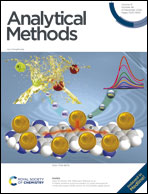A mix-and-detect method based on colloidal gold immunochromatographic assay for on-site detection of zearalenone in edible oils†
Abstract
The common methods to detect zearalenone (ZEN) in edible oils need organic solvents to extract ZEN and then some sample purification process before detection, so, it is not convenient for on-site use. Here a simple method without organic solvents and a sample purification process was developed for the determination of ZEN in edible oils. The detection process only needs mixing oil with a surfactant solution in the indicated ratio and then loading the mixture onto a colloidal gold immunochromatographic (CGI) strip for detection. The optimized surfactant was AEO15 among the seven surfactants studied in this paper. The ZEN residue in edible oil could be quantitatively determined with a detection limit of 44.3 ng g−1, and the working range of the standard curve was from 50 to 800 ng g−1. This method has been successfully applied to the detection of ZEN in plant oils with recoveries ranging from 81 ± 7% to 129 ± 9% for spiked samples. The detection results for the ZEN residue in oil samples from a local market by this method were in good agreement with those obtained by the national standard method.



 Please wait while we load your content...
Please wait while we load your content...